 |
DRY RISERS
A dry riser is a supply system intended to distribute water to multiple levels or compartments of a building, as a component of its fire fighting systems.
They are advantageous to the fire service in two respects. Firstly they provide a fixed distribution system within the building that requires no fire service resources or equipment. Secondly it is designed as part of, and to maintain, the compartmentation of the building.
Dry risers are a building regulations requirement in occupied buildings over 18M tall. The designers or architects may opt for the superior protection of wet risers. Wet risers are a building regulations requirement in buildings over 50M.
Dry risers may also be found in environments where access is limited or compartmentation is an issue (i.e. multilevel basements, car-parks or hospital corridors)
In its simplest form a dry riser will consist of 3 components (usually designed to meet BS 5041 BS 5306, BS 9990 and Building Approval Regulations)
EXTERNAL INLETS
Inlets enable connection of Fire service water supplies. This is conventionally in an external cupboard or enclosure marked “DRY RISER INLET”. Within this enclosure is a collecting head with at least 2 BS Instantaneous male couplings. Also in this cupboard is a drain down valve to enable the dry riser to be emptied of water following fire service operations or testing.
These enclosures should be secure from vandalism but immediately accessible. They usually have a breakable area in the door to facilitate urgent fire service connection.
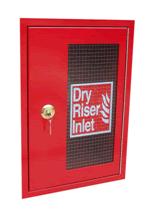 |
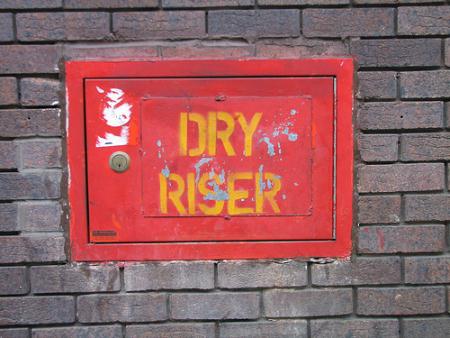 |
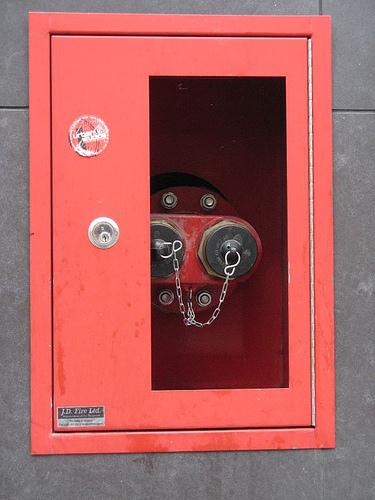 |
PIPEWORK
The pipe is maintained EMPTY of water. The dry riser is the opposite of a "wet riser" or "wet standpipe" system where the pipes are kept full of water for manual or automatic fire fighting operations.
The pipe work of dry riser distribution systems is usually of Galvanized steel pipe. British standards lay down requirements for the pipes internal diameter.
In most occupied buildings over 18 meters (effectively over 6 stories as a story has a notional height of 3M) where single outlets on each floor are provided, 100mm or 4 inch internal diameter pipe work is fitted. For taller buildings and for situations where multiple outlets on floors are required then 150mm or 6 inch internal pipe work is fitted. Larger diameter dry riser pipe work is usually accompanied by a 4 way inlet collecting head.
The construction, design and layout of the dry riser pipe work within the building can influence its performance (flow characteristics). The pipe work is usually enclosed within fire resisting enclosures or shafts.
The top of the pipe work will have an air valve. This allows the air in the dry riser to be expelled when it is charged with water.
Dry Rise Air Valve 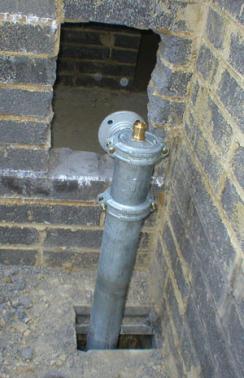
OUTLET POINTS
Outlets (or Landing Valves) are connection points to enable the fire service to attach and advance its hose lines within a building. Each outlet consists of a single or double BS instantaneous female outlet, under the control of a gate valve.
 |
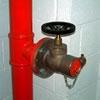 |
 |
Similarly to inlets, outlets may be protected by enclosures They also have a breakable area in the door to facilitate urgent Fire Service connection. Outlets are usually situated in a protected lobby, stairway or cupboard, usually one of a buildings fire escape staircases, enclosures or lobbies.
Locally, Dry riser outlets may be referred to as standpipes, landing valves or landing outlets.
Provision is often made at roof level for an additional “testing” outlet
Design and layout
Newer installations are controlled by Building Regulations and British Standards but in older constructions many variations to this may be evident.

Dry risers are required to have fire appliance access within 18m of the dry riser inlet box. (Building (Minimum Standards) Regulations 2000) There is also design requirements that there is a provision for outlets:
One is provided for every 900m2 of floor area at each level other than ground floor
They are not more than 60m apart in a horizontal direction
No part of any floor area is more than 60m from an Outlet, measure along a route suitable for hose lines
Maintenance and Testing
Fire crews should be familiar with the layout, function and operatoin of dry risers. They should have specifically knowledge of those in their risk area.
If any building (fitted with a dry riser) is a regarded as a special or specific special risk (PRM/SSRI) then detailed information on the riser’s size, location and performance limits should be included within any risk data.
The annual testing and maintenance of both Dry and Wet Risers is the responsibility of the property owners or managing agents.
Some UK FRS have the provision to assist owners with testing of Dry Risers (Sometimes this is a chargeable service)
British Standard 5306: Part 1 1976 (Revised by BS9990) recommends that the system is visually inspected every 6 months and serviced annually to ensure that the equipment is ready for immediate use in an emergency. In addition, it is recommended that a ‘full wet test’ be carried out annually, comprising of a wet pressure test to 150 PSI or 10 Bar subjecting the mains to a full working test.
Operational use.
Finite supply. The most important consideration when using Dry risers is that they are only capable of giving a finite water supply. This is a crucial factor that must be part of any tactical selection by the IC. There should be 5 things to review: 1. A suitable permanant supply to the Dry Riser (always twinned lines) 2. The diameter of the dry riser (commonly 100mm in the UK). 3. The height to which water will be pumped (head) 4. Hose line deploymment (losses through diameter and length) 5. Branch type (Automatic, non-automatic, smothe bore etc..) Photo: http://www.mcc-ltd.com
Pump Operations.
The effectiveness of a dry riser is directly related to the skills and proficiency of the pump operator. Pump operators must be particularly observant when supplying a dry riser. Communication between Branch operators (both visual and verbal) will be very limited. Effective use of the pump gauges will help the pump operator know what is happening within the building.
On arrival at an incident the pump operator should start to lay out suitable hose lines and set up a hydrant as soon as possible. The dry risers should be charged ONLY at the request of the OIC. In operation they should always be supplied by a dedicated pump. Each inlet connection point (hose connection) should have its own supply hose. Hydrants supplying dry riser base pumps must have twined supply lines. If at all possible these hydrants should be on a separate water main from any other hydrant in use on the fire ground.
Unless otherwise instructed the pump operator should charge the dry riser to 10 Bars.
There are many factors influencing the final pressures and flow rates the branch operator may expect. These include Incident height, pump pressure, Dry riser pipe diameter, number of outlets in use, length of hose line (from outlet to branch) and branch design.
Hose Lines
Water flow and pressure are directly (inversely) related. In most incidents where a Dry Riser is used, flow rates are the most important factor. Fires in Buildings fitted with dry risers (primarily high rises) tend to be higher energy, well ventilated fires that require larger quantities of water to extinguish safely.
Crews within a building should check the pressure and flow of their hose lines before entering any risk area. Any deficiencies must be immediately reported to OIC.
Hose line deployment should be carefully considered by crews laying them out in small lobbies or corridors. Hose lines must not breach or obstruct any door that is deemed crucial to maintaining a smoke free egress. Whenever possible use larger diameter hoses (51mm or 70mm) as these will facilitate better flow.
If two hose lines are to be laid out from a single dry riser outlet, use of a controlled dividing breeching wherever possible is recommended.

OIC and Crews must bear in mind, at all times that dry risers can only provide a finite flow. Having multiple hose lines working will seriously effect flow rates at each branch.
Dry Riser failure
A defective or otherwise inoperative dry riser will seriously effect fire service operations. Riser failure can be brought about through many factors. An open outlet, restrictive blockage, mechanical failure of the pipe work, vandalism and more recently theft of the inlet/outlet fittings.
At any time there is an issue with the correct functioning of a dry riser, the OIC must be informed immediately. He/she should make an immediate reassessment of available resources and, if required, order on additional appliances to maintain control of the incident. All reasonable steps should be taken to rectify a dry riser failure as a matter of urgency.
The most common reason for water failure or low delivery rates is an open outlet valve. Should this happen on a floor below the bridgehead this may be quickly remedied by deploying a crew to check these outlets.
If it is suspected that there is an outlet open above the bridgehead, then the OIC must risk assess how safe it will be to deploy a BA crew to rectify this problem. This risk assessment will include factors such as personal protection of BA crew, extent of fire travel, degree of smoke logging, integrity of fire and smoke compartmentation, location of incident in relation to stairwell, effectiveness of communications systems.
If the dry riser is deemed to be completely inoperative then the OIC must consider alternative ways to supply water to the incident floors/compartment. This may be a complex process as the OIC must endeavor to maintain the compartmentation of the building, as this is what protects and provides safe access and egress.
What may appear as a simple solution to riser failure…Laying hose up stairwells.. Will undoubtedly breach compartmentation and will lead to premature smoke logging of the stairwell should hose lines be extended into the affected area.
In single stairwell buildings consideration should be given to hauling hoses up externally. In high rise buildings this will be limited to 2 lengths of hose. These hoses should enter the building through windows/balconies on the fire floor as far away as possible from the compartment/flat that is involved. Use of an ALP/TL may be of assistance in this task.
In all instances where a dry riser fails or is inoperative a controlled and well resourced alternative must be initiated as a priority.